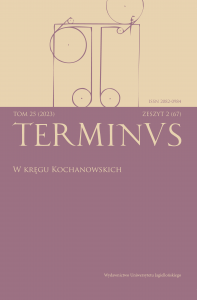Czy pochodzenie od Jana Kochanowskiego było powodem do dumy? Genealogia eksponowana w drukach okolicznościowych poświęconych potomkom poety (XVII–XVIII w.) Część 1. Potomkowie Zuzanny z Owadowskich Wołuckiej
Was being a Jan Kochanowski’s descentant a reason to be proud? Genealogy present in works devoted to the poets’ descentants (17th-18th centuries)
Part. 1. Zuzanna Wołucka’s (nee Owadowska)’s descendants
Author(s): Mariusz KozdrachSubject(s): Polish Literature
Published by: Wydawnictwo Uniwersytetu Jagiellońskiego
Keywords: encomium; genealogy; Jan Kochanowski; enatic descendants; memory; prestige propaganda
Summary/Abstract: This study explores the genealogical awareness of the Polish nobility and the role of outstanding individuals in creating collective memory. More specifically, it offers an analysis of genealogical references included in encomia devoted to Jan Kochanowski’s enatic descendants, in the context of their famous ancestor’s literary output and his fame. Coming from the line of Zuzanna Wołucka, nee Owadowska, Jan Kochanowski’s granddaughter, the descendants inherited parts of the poet’s real estate and buried their relatives next to his Zwolen mausoleum till the end of the 18th century. The article is based on commemorative prints devoted to the poet’s descendants: Falces avitae ad lauream vernantis gloriae messem by Wojciech Zatoński (1696) written in honour of the Sieradz castellan’s wife Zofia Lipska nee Olszowska, Chwalebny zawód do kresu szczęśliwego by Krzysztof Wierzbicki (1699) in honour of the Sieradz chamberlain’s daughter Konstancja Zapolska, Niebo herbownego Księżyca by Samuel Wysocki (1732) lauding the Gostyn staroste’s daughter Zofia Lipska nee Granowska, as well as the anonymous Panegyricus probatissimo magistro belli in sago (1757) devoted to the Rawa palatine Kazimierz Granowski. None of these pieces includes any references to Jan Kochanowski, which can be explained by the social status of these newly promoted to state offices families with middle- to petty-nobility roots. The need to legitimize their position as the noble well-to-do class holding state posts required to show connections with sufficiently important ancestors who also held state offices, rather than by giving prominence to the genealogy and the past generations.
Journal: TERMINUS
- Issue Year: 25/2023
- Issue No: 2 (67)
- Page Range: 169-220
- Page Count: 52
- Language: Polish

